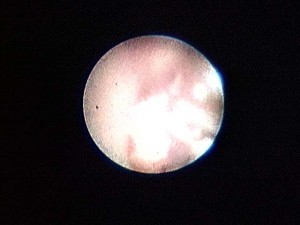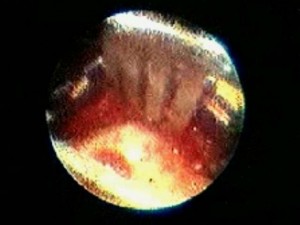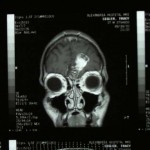The Brain Surgery Experience
I Have Some Questions

This is what the fiber optics of the endoscopic send back to the monitor. Not easy to see what you're doing I should I think.
At this point I had done some reading about both types of cysts, especially the colloid. I had come across an illustration showing a endoscope being positioned to remove the colloid cyst, but I couldn’t figure out how they were going to get around the brain to do it. As you can see from the scans on this site the third ventricle is pretty much in the middle of the brain. So I asked:
Me: “How do you get to it?”
Doctor: “We just bore right through the brain.”
Me: “OK, sounds good.”
Doctor: “You see the brain is not like those that you see on TV where they have been preserved. The living brain is actually very soft and the tissue fibers for the most part just separate and move aside as the scope is inserted.”
Me: “What are the risks?”
Doctor: “Hitting an artery. But we know where all the major ones are.”
There were some other risks. I was told by the doctor who would remove the dermoid cyst that there was a “small risk that you will lose your sense of smell.” The surgeon who would perform the endoscopic was pretty certain I would have short term memory problems for about a month because of the area of my brain he would be working in.
Me: “So, I won’t remember what I had for lunch?”
Doctor: “Well, you’ll remember that you had lunch, but not what it was.”
In my separate meetings with the two doctors I asked each of them when I needed to have this done. Both of them said that it wasn’t an emergency. I was told, and I had also read, that the colloid cyst was the only one that had any potential for sudden problems, but that they didn’t think I was in any immediate danger. Apparently, doctors used to be very concerned by the risk of hydrocephalus if the cyst were to block the flow of cerebrospinal fluid in the third ventricle. That situation is still considered a neurological emergency and can result in sudden death.
Conventional wisdom now appears to be that this type of cyst can be monitored with yearly MRIs. If the symptoms (headaches in my cases) become more severe or if the cyst is growing I think they prefer to operate. Since this cyst had probably been there since birth, and I was 37 at the time, and it didn’t appear to be near to blocking the ventricle I wasn’t too worried.
As a matter of fact I wasn’t very worried at all and the doctors and my friends kept telling I was taking it really well. I got the feeling that everyone thought I should be losing it. All things considered I figured I had everything going for me and it just didn’t seem like a big deal. The more I learned, the less I worried. All that said, since we were going to operate to remove the dermoid cyst we all agreed to go after the colloid cyst at the same time.

Scary movie. No, that's not a fork in my head. This picture is from the endoscope. There are some long pauses, but you'll notice they also captured video when the scope was outside of my head. My bare skull is visible and my scalp is stretched apart.
This was the fall, and I asked if I could get it done after the Christmas holidays. I wanted to enjoy the time off with my family as well as not mess up things for everyone else, especially the kids. The doctors agreed that January would be fine and that I should get back in touch in early December to begin planning. Despite the lack of urgency one doctor said “I suggest you carry the card of a good neurosurgeon in your wallet.” And when I asked the other doctor if I should avoid any particular activities he said “I wouldn’t ride any rollercoasters.” Huh? I asked about that in a follow-up appointment after my surgery. The explanation was that often colloid cysts are “pedunculated” which means the cyst hangs like a cherry on a stem that is connected to the ventricle wall. This means the cyst is able to swing around and could block the ventricle if it is somehow slung into the right position. Apparently when small children are suspected to have hydrocephalus caused by this the medical staff will make them put their heads down between their knees in an attempt move the cyst and allow the cerebrospinal fluid to flow. Fortunately for me my cyst was/is securely attached.
Despite the fact that I was probably more educated than the average bear about the surgery and my brain in general I began to worry that I wasn’t worried enough. Up until the last week or so before surgery I just wasn’t worried at all. But I started to think: “Maybe I’m overlooking something because everyone seems to think I should be freaking out.”
(Here’s a video of part of the endoscopic surgery to remove the colloid cyst.)

Leave a Reply